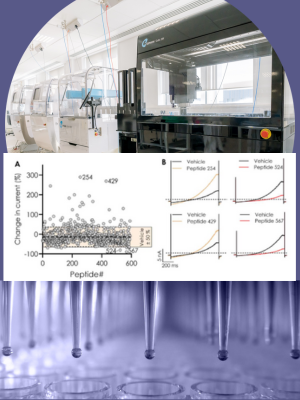Two-pore domain K+ (K2P) channels are a family of four-pass transmembrane K+ channels that dimerise, as homomers or heteromers, to form a functional K+ channel complex capable of regulating membrane potential through a background K+ conductance. K2P channels have widespread tissue expression, and within the nervous system they play a key role in membrane hyperpolarisation and the regulation of neuronal excitability. Moreover, these channels are implicated in a range of neurological disorders, such as pain, depression, epilepsy, mental developmental disorders, and migraine, and therefore represent attractive drug targets for these conditions.
In this application note, we report the development and optimisation of a TREK-1 functional assay using the Qube 384, an automated patch clamp platform capable of supporting high-throughput screening.
The assay was optimized to identify both activators and inhibitors on the same plate, providing key mechanistic data for high value, limited supply screening libraries such as venom fractions used in this study.

Two-pore domain K+ (K2P) channels are a family of four-pass transmembrane K+ channels that dimerise, as homomers or heteromers, to form a functional K+ channel complex capable of regulating membrane potential through a background K+ conductance. K2P channels have widespread tissue expression, and within the nervous system they play a key role in membrane hyperpolarisation and the regulation of neuronal excitability. Moreover, these channels are implicated in a range of neurological disorders, such as pain, depression, epilepsy, mental developmental disorders, and migraine, and therefore represent attractive drug targets for these conditions.
In this application note, we report the development and optimisation of a TREK-1 functional assay using the Qube 384, an automated patch clamp platform capable of supporting high-throughput screening.
The assay was optimized to identify both activators and inhibitors on the same plate, providing key mechanistic data for high value, limited supply screening libraries such as venom fractions used in this study.

Two-pore domain K+ (K2P) channels are a family of four-pass transmembrane K+ channels that dimerise, as homomers or heteromers, to form a functional K+ channel complex capable of regulating membrane potential through a background K+ conductance. K2P channels have widespread tissue expression, and within the nervous system they play a key role in membrane hyperpolarisation and the regulation of neuronal excitability. Moreover, these channels are implicated in a range of neurological disorders, such as pain, depression, epilepsy, mental developmental disorders, and migraine, and therefore represent attractive drug targets for these conditions.
In this application note, we report the development and optimisation of a TREK-1 functional assay using the Qube 384, an automated patch clamp platform capable of supporting high-throughput screening.
The assay was optimized to identify both activators and inhibitors on the same plate, providing key mechanistic data for high value, limited supply screening libraries such as venom fractions used in this study.
